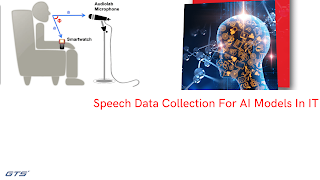Remote Speech Data Collection For AI Models In IT Sector
Data is becoming an increasingly important part of today's digitally superhuman world. Data is essential for everything, including business forecasting, weather forecasting and even the training of artificial computers. Machine learning uses high-quality testing and training data to train its models.
Siri and Alexa are two common examples of voice or speech recognition software that has been trained. There is still much to be done in this area. As it is unlikely that a AI Training Datasets with all the training data will be available, companies should work with specific requirements. This is done by using speech data collected from multiple source.
Let's now see what speech data collection actually is and how it can benefit speech recognition software.
Artificial Intelligence, or AI, is a buzzword you have most likely heard of or read about. You may recall articles on robots, technology and the digital age when you hear the word AI. What is AI and how does it work? AI in technology is a concept which determines the future of technology and all it entails. AI has not only revolutionized traditional computing methods but also penetrated many industries and substantially transformed them.
Artificial Intelligence in Technology
AI in technology refers to the development and theory of computer programs that can perform tasks and solve problems that would normally require human intelligence. Vision, Speech Recognition Dataset and decision making are all tasks that normally require human intelligence. However, computer programs can solve these problems using their intelligence and capabilities. This type of intelligence was born in June 1965, when scientists and mathematicians met at Dartmouth to discuss the idea of a computer capable of thinking for itself. Although they didn't know what name it or how it would function, their discussions led to artificial intelligence.
What is Remote Speech Data Collection?
Remote speech data collection is the process of collecting data from different sources and then processing it to create data sets that can be used in Conversational AI. It is also called audio collection. Remotely collected speech data can be accumulated via a mobile app, or a web browser.
A set number of participants is typically recruited online based upon their language and demographic profile. Next, they will be asked to record speech samples in order to test different scenarios, narratives and conditions. These data sets can then be prepared and used for various purposes, if necessary.
What is the role of AI?
Understanding the underlying functions of AI is a different thing than knowing what it is. Artificial Intelligence is a process that processes data using complex algorithms. It uses algorithms to sort large data sets and learn from patterns or other features. The AI systems have many theories and subfields, including:
- Machine Learning: Neural networks are used to extract hidden insights from data. They can be programmed to find or draw conclusions. Machine learning is an effective way for programs to identify patterns and increase their intelligence over time.
- Deep Learning: Deep Learning uses large neural networks with many layers. This allows them to leverage their size to process huge amounts of data and create complex patterns. Deep learning is similar in that it works with larger datasets and has more layers.
- Cognitive Computing: Cognitive computing aims to create human-like interactions with computers. Robots that are able to hear, see, and respond like humans can be called cognitive computing.
- Deep learning and pattern recognition are two of the most important tools in AI for understanding a photograph or video. Machines can see around, take photos and videos and interpret the surroundings in real time.
What are the pros and cons of remote speech data collection?
Remote audio data collection is just like any other technology. Let's take a look at the following:
Pros: Here's a list of benefits of speech data collection
- Cost-Effective Solutions: It is cheaper than meeting people face to face to collectremote data via apps.
- High Customizability: The data can be customized or modified according to the training data specifications.
- Greater Scalability:Crowdsource workers have the ability to collect data within their infrastructure. This allows for greater flexibility and gives them the option of scaling up or down.
- Data Ownership: You own the data.
- Speech Data: You can collect different data sets, such as command-based, scenario-based or unscripted speech.
Cons: There are some cons to speech data collection
- Different Audio Specifications for Different Users: The biggest challenge is to make the data consistent. You can get all types of output files because participants may use different digital recorders or devices to record their voices.
- The Speech Transcription doesn't provide the best results when you require a specific background scenario. You will need to hire an individual voice artist for such situations.
What can GTS do for you?
Global Technology Solutions recognizes the importance of training data for your learning models. This will allow you to optimize your algorithms. These models do not require any data. These models require high-quality, large datasets. When it comes to understanding intent and managing subjectivity, humans are more efficient than computers. A

Comments
Post a Comment